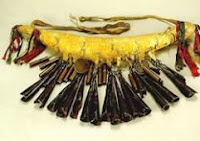 |
| Buryat shaman’s belt |
The first seventy years of Soviet power, writes historian Philip Walters, “saw a sustained offensive against religion on a scale unprecedented in history.” Shamanism — sometimes called black faith — was a particular target; shamans in Siberia were subject to public denunciation, confiscation of their property, and imprisonment. Their drums were impounded, and they were branded kulaks, class enemies — not a frivolous charge, since many shamans were in fact centers of anti-Soviet resistance. Olga Kharitidi tells how, in the 1930s, a number of influential Altai shamans were taken by Soviet KGB employees to Kazakhstan and dumped from a train into the snow.
 |
| Buryat shamans |
The decimation of shamanism in the former Soviet republics is slowly being reversed, impelled in part by growing nationalisms and ethnic pride. One sign of this revival is today’s announcement of a new shamanism exhibit at the Buryatia History Museum in Ulan-Ude. The exhibition is based on a unique collection gathered by the ethnographer and folklorist Sergei Baldayev in the 1920s through the 1950s, and includes shamanic masks, pictures, amulets, and costumes, many being displayed for the first time.
If you’re planning on being in Ulan-Ude in Buryatia any time soon, you should check it out.

- Previous Post: Khadak
- Next Post: Canaima
- More Articles Related to: Indigenous Culture, Shamanism



Fascinating blog! I was in Irkutsk and the Buryat Republic last week and met a very interesting crown shaman. I’ll be in the Peruvian Amazon the week after next. Glad to have found your blog.